I invite you here
Traveller from afar
You come bearing story
A lantern in the dark.
I greet you here
I welcome what you bring
Though it may be hard to listen to
I know you’ll bring a change in me.
Whoever you are you’re welcome
Come sit here by my fire …
Ayla Schafer, The Guesthouse
February sunset at the alder carr
As a bird soars high
In the free holding of the wind,
Clear of the certainty of ground,
Opening the imagination of wings
Into the grace of emptiness
To fulfil new voyagings,
May your life awaken
To the call of its freedom.
John Donahue, from For Freedom in Benedictus: a Book of Blessings
New Moon in Pisces
So here we are, at the Pisces new moon. Pisces energy is said to be dreamy and creative, and at Art School there actually were an exceptional number of Pisces students. (There were lots more left-handed people than you’d expect too, including me, but that’s another story … )
Are you feeling a new sense of awakening, of freedom? Are you ready for whatever this new Tide may bring? I THINK I am, but I definitely find myself having to try extra hard to go with the flow and practise non-attachment. After all, one moment we can be watching buds unfurl with the warm sun on our faces and the next moment a sudden hail storm tosses us back into the arms of winter. My heart always goes out to the creatures and little green shoots who are lured out to play and then must surely wonder what on earth is happening as everything is turned topsy turvy again.
Still, if there’s one thing that personifies the season it’s hope, and if there’s one thing that personifies hope, it’s the snowdrop.
In my tiny woodland garden, February 2023
I think these must be the frilliest snowdrops I’ve ever seen. All those lace petticoats to unfurl and shake out! Each flower has to open almost flat to accommodate them all.
This little clump seemed to appear from nowhere at the edge of my tiny forest here at The Old Shop. It was a delightful surprise as I have no idea where they came from. I must have transplanted them from somewhere but I really don’t remember, so I’m putting it down to a bid by the Fair Folk to charm the garden back to life ;)
Of course I had to look up some of the folk names for the snowdrop: it’s known variously as Candlemas Bells, February Fair Maid, Mary’s Tapers, Snow Piercer and Dingle Dangle. Who knew?
Apparently, for all its demure appearance the snowdrop holds its share of controversy, as no-one is quite sure whether it is actually native to the British Isles. It’s first mentioned as growing wild in the 1770s in Gloucestershire and Worcestershire, yet it’s referred to as a garden plant in 1664. Then again, in the first edition of Gerard’s Herball published in 1597 there is an illustration and description of it under the name of ‘Bulbous Violet’!
The names Mary’s Tapers and Candlemas Bells indicate quite an early date for it, since the Catholic feast of Candlemas was mostly abolished at the Reformation and it is frequently to be found growing in abundance around ruined monasteries and priories (of which more in a moment).
One thing I hadn’t taken in until recently is that snowdrops spread across woodlands or hillsides particularly slowly, and because of the timing of their flowering this happens mainly through bulb division rather than by self-seeding. This means that where you find masses of snowdrops carpeting the land it’s a good indication of undisturbed earth or ancient woodland. Conversely, they spread especially rapidly along stream and river banks, the water carrying bulbs downstream to colonise new areas. The contrast between these wildly different paces, both of equal value to the species, feels significant somehow and worth meditating upon. We learn so much from plants!
Coffee stop on the way to Walsingham, 14 February 2023
Our Lady of Walsingham
But Maria could not stay long looking at the Bell because Peterkin Pepper was pulling at her hand, dragging her towards a niche in the wall where there was a statue of a Lady with a baby in her arms. It was a small wooden statue, not much bigger than a doll, and so worn by age and the caressing hands of many children that the features of the mother and child had nearly been worn away. But the sweep of The Lady’s cloak was lovely and graceful, and so was the proud poise of her head, and the baby had his hand upraised in blessing and a smile upon his face. The children had put two vases of flowers in the niche, one on each side of the statue.
“We always give The Lady something pretty,” said Prudence Honeybun. “Sometimes in the winter it’s only berries or birds’ feathers that we’ve picked up. But it’s always something.”
Elizabeth Goudge, The Little White Horse
The tiny clumps of snowdrops in my garden are such a joy. There are even solitary flowers here and there which are easily overlooked (though I try not to). But if you want to see one of the most spectacular arrays of snowdrops that there is, the place to go is Walsingham Abbey.
Last week, on a whim, I went to Walsingham. More properly, it’s Little Walsingham, as there is also a nearby village of Great Walsingham which is, weirdly, far smaller. It was a beautiful day, Valentine’s Day in fact, and I thought I would like to wander around somewhere that my husband and I often used to visit. I also felt for some reason that I needed to find a little statue of Our Lady of Walsingham to bring back to The Old Shop with me. And trust me, it’s not difficult to find one of those in Walsingham. It’s the sort of place you either love or hate - a little like Glastonbury in that respect - but I love it. And when I looked at Google Maps and discovered that I could get there in an hour when I’d imagined I now lived a lot further away than that, what else could I do but pack up my flask and a snack and head out in the van?
At the start of the journey I was still berating myself for not staying home and doing some of the myriad things that needed doing, but as I drove through the glorious undulating landscape that characterises that part of Norfolk an overwhelming sense of joy and gratitude calmed me down and I knew I’d made the right choice.
Now, I could write a whole newsletter about Little Walsingham and maybe one day I will, but for now I just wanted to note the deep connection between St Mary and the snowdrop. All around the village, images of each were to be seen around every corner and at this time of year, at least, they seemed to be venerated in equal measure. I didn’t pay for the official Abbey Snowdrop Walk but could see through the railings that the sea of snowdrops stretching between the trees was like something out of a dream. Strangely, an image has just come back to me of the beautifully-lettered sign I saw swinging from a building in Walsingham, bearing the words ‘Mary, Star of the Sea’.
Snowdrops at Walsingham Abbey
From a year ago - Magic at the Carr
The alder carr down the lane is so sparkly at the moment that I decided to take my Mermaid’s Head candles there to imbue them with a little of its magic.
This fairy stump seemed the perfect place to perch each one, while great-tits flitted between birch and alder. As I’m told that merfolk are to be found in all watery locations and not just the sea, my hopes were high that these little pots would catch the eye of a mermaid or two and not just the roe deer who leapt across the neighbouring field while I worked.
Mermaid’s Head candle at the Carr, February 2022
Afterwards, the flask came out and coffee was consumed as I sat between the mossy roots of an oak tree. While I sipped I found myself thinking about the different ways that we humans find meaning in nature.
There’s the magic inherent in the science of nature, as all who have been enthralled by a David Attenborough documentary will testify.
Then there’s nature as metaphor. Twining ivy makes us think of clinging or of embracing, new shoots show fresh inspiration, the thrust of a snowdrop speaks of hope eternally sprung.
Something I feel in nature is a closeness to the ancestors. Knowing that many sights, sounds, tastes, smells and textures would have been equally familiar in prehistory feels like a direct and vital link with those in whose footsteps I now tread. Making teas and salves and incense brings us even closer.
And nature can help us to share tender space with someone we’ve loved and lost. As we spend time in environments they cherished, a gentle healing can percolate. Maybe we visit at a specific time, or find comfort in witnessing the circling of the seasons. Perhaps we light a candle. Certainly, there seems to be a universal human impulse to perform ritual whenever or wherever the veils between the worlds are thin. As, of course, they have the potential to be at any given moment, in any given place.
‘I wanted to let you know that your beautiful River Song candle has found a home with my mum after all. My dad visits the wood where she is buried most days and he takes the River Song candle with him. He stands by her grave and talks to her and places the candle each time on her grave between ferns and woodland leaves. It is lit and he has a moment of candlelight and peace with her. Thank you. Your candle has given my dad a little strength to get through these days’ - Charlotte
The Fairy Hare
Seven magical vessels came with me to The Old Shop, carefully wrapped and kept safe until the cottage was habitable. I decided to seek out a special location in which to photograph each one, as a way of weaving them into the land here between the heath and the sea.
Of course, they carry a story.
Each year we would follow the silvery thread that connected our home in Norfolk with the far west of Cornwall. Once I fell in love with a pottery bowl, all otherworldly-blue and edge-of-sky-and-sea. Leaping about its belly was a pair of hares, rusty-brown as heath litter. That little bowl came home with us, along with a legend.
The gallery owner, guardian of hares, shared snippets about this scrap of magic that sparked between my hands. Michele Cowmeadow transported her work by bus and played her recorder at the bus stop. She sang, and spoke several languages. She had no social media presence, no email, no website, indeed was uncontactable even by her galleries for an hour and a half each morning while she meditated. She sounded gloriously bohemian and eccentric, but more than this, there were the pots themselves.
Michele’s pots were boldly shaped, her subjects the stuff of wonder. Hares, mermaids, galleons, winged horses, dragons, wild geese (or were they swans?), a stag springing lightly after a doe. We started a tradition of choosing a pot to bring back to Norfolk each year, a reminder now of treasured times.
Seven is, of course, the number of chakras, notes in a scale, colours of the rainbow. Gradually, I’ve come to associate each one with a different day of the week and often place the vessel somewhere I will notice it during its ‘day’. To catch the eye of a dragon on a Tuesday or a flying horse on a Sunday is to add a tiny point of brilliance to the day.
Here is my Thursday vessel, nestled within the roots of a strong boundary oak, the wildest of fairy-hares curled within the curve of a platter.
Hare in Acorn Wood
The Devil’s Mill
A tale for wild and windy weather.
After bumping over ridge after ridge, the Land Rover ground to a halt. ‘We have to walk the last bit’, explained Anna, whose ancient vehicle had carried us here. I scrambled down from the passenger seat and followed my guide through brambles and reeds to stand, heart thumping, before The Devil’s Mill.
Earlier that day I had answered a Marketplace ad for an old decorative cast iron grating. It called to me strangely insistently, despite not knowing what I would do with it. Perhaps it would look nice somewhere in the garden. The address wasn’t far away and I arranged to go to take a look.
Once, the sails of windmills creaked and spun in almost every village, and wind pumps sang along the rivers and reed banks. Some still stand in lonely reminder, making me jump when they hove into view. A ghostly mill even sits within the abandoned medieval gatehouse of St Benet’s Abbey and you may think that would take the prize for the weirdest survival.
But then, you might not know about the Devil’s Mill.
Brograve Mill was built in 1771 by the notorious Norfolk baronet Sir Berney Brograve. Fantastical legends about him abound, some of which are undoubtedly true. Most famously, he made a pact with the Devil in a mowing contest against his diabolical opponent - an agreement he had no intention of keeping.
One dark and stormy night while trying to hide from the Devil, Sir Brograve sought refuge in his mill. The Devil couldn’t get in and beat frenziedly on the door. In the morning the door was covered in hoof prints and the mill now leaned to the west. Five times the villagers have tried to shore up and straighten the mill and five times it has tilted again to the west, as the Devil willed it.
Derelict and skeletal, illuminated by sun or silhouetted against gunmetal skies, the mill never fails to provoke a shiver. A delicious bonus is its inaccessibility, lying as it does on private land so that it can only be viewed from the other side of the water, and often as a distant speck.
Unless, that is, something catches your eye on Marketplace and you discover that the sellers are the owners of that private land …
Brograve Mill, Norfolk - The Devil’s Mill
Shrovetide
As I write this on the new moon, tomorrow will be Shrove Tuesday or Pancake Day. Because of the dating of Easter which varies each year (Easter Sunday is always the first Sunday after the first full moon after the Spring Equinox), this celebration marking the last day before the austerity of Lent is very much a moveable feast.
According to Nigel G Pearson in Walking the Tides, Shrove Tuesday was anciently known as Fastern’s E’en, Guttit Tuesday, Bannock Night or Doughnut Day. It was the day when all the rich foods like eggs and butter had to be finished up before the 40 days of Lent, during which time they were not allowed.
There are myriad regional customs involving different types of cake, scone and pancake, each with their own traditions attached to them. Probably the most famous is the Olney Pancake Race, dating back more than five hundred years, which is held on Shrove Tuesday every year in the town of Olney in Buckinghamshire. The course is 415 yards long and runs from the market place to the church. All the participants must be women who have lived in Olney for at least three months.
Tradition has it that the race was first run on Shrove Tuesday 1445, and that the whole day was given over to a festival of celebration, pranks and pastimes. It is not known where the original start line was but the finish line was at the church door. The race continued through the centuries, and whilst it sometimes lapsed it was never entirely forgotten by the womenfolk of Olney. The event even took place during the turbulent times of The Wars of the Roses (1445-1487).
After a pause during the Second World War, the race was revived again in 1948 by the Reverend Canon Ronald Collins, vicar of Olney. While he was clearing out a cupboard he came across some old photographs of women running with frying pans that had obviously been taken in the 1920s and 1930s. Keen to revive the custom he called for volunteers to come forward, as a result of which 13 runners competed for the prize on Shrove Tuesday that year. The race immediately caught the popular imagination and the people of Olney embraced this simple and colourful link with their rich past.
While the dress code may now be more relaxed, competitors still pay homage to ‘the traditional costume of a housewife’ (sic) by wearing a skirt, apron and head covering while carrying their frying pan containing a pancake. On crossing the line the winner must toss her pancake and ‘she is then greeted by the verger with the traditional kiss of peace’. The race is immediately followed by a Shriving service in the Parish Church. No, I don’t know what a Shriving service is either, but I’m guessing it’s confessional. Which may be apt, given the high spirits no doubt set alight by the race for the verger’s kiss ;)
All of these pre-Lent cakes may have their origins in those made by our Anglo-Saxon ancestors, as February was known to them as Solmonath or Flat Cakes’ Month. According to the Venerable Bede the people would make small cakes to honour their deities and the return of the sun after the darkness of the winter months. Even though the strictures of Lent lessened after the Reformation, the custom was so deeply embedded that it continued regardless, as it has to this day.
In a similar folk custom to those performed at other times of year, small tokens were sometimes placed in the cakes in order to divine the finder’s fortune. In other traditions, portions of Dumb Cake - which had to be made in absolute silence - were placed under the pillow while sleeping to induce prophetic dreams of one’s future. Usually this seems to have meant - if you were a young girl, anyway - dreams of the one you were to marry.
After that, of course, the fun and merriment was meant to cease for the 40 days of Lent. But knowing our ancestors (and ourselves) I’d be surprised if this tenet was always followed religiously ;)
Be that as it may, I really wanted to share this favourite pancake recipe with you. It’s based on an early Deliciously Ella one but I’ve adjusted it to make it far more lemony than the original. I try to only make this particular version on Pancake Day so that they stay special. You know what I’ll be eating tomorrow! If you try them, let me know what you think.
Shrovetide Lemon Cardamom Pancakes
2 tbsp chia seeds and 4 tbsp water
150ml plant-based (or other) milk
1 banana
100g buckwheat flour
5 cardamom pods, seeds crushed or 1 teasp ground cardamom
Zest of 1 lemon
Coconut oil to fry
For the drizzle:
1 teasp coconut oil
Zest of 1 lemon
Juice of 2 lemons
3 teasp honey or maple syrup
Mix chia seeds and water and leave in the fridge for about 30 minutes. Mash the banana and add to a blender with ground cardamom, lemon zest, buckwheat flour, milk, and soaked chia seeds. Blitz until well combined.
Heat the coconut oil in a non-stick pan and cook the pancakes, flipping when bubbles form and adding more oil as needed. The mix should make about six pancakes.
For the drizzle, stir together coconut oil (you could melt this at the beginning), honey or maple syrup, lemon zest and juice.
Stack your pancakes and serve with the drizzle.
Until we meet again at the full moon, I’ll leave you on the Heath. If you skip through the arch you’ll find yourself in the sunshine on the other side, one step closer to spring.
Heath archway, 18 February 2023
A few resources
Nigel G Pearson, Walking the Tides: Seasonal Magical Rhythms and Lore, Troy Books 2017.
John O’Donohue, Benedictus: A Book of Blessings, Bantam Press 2007.
Ayla Schafer, Ima Adama album, available via Bandcamp and highly recommended.
Olney Pancake Race history:
http://olneypancakerace.org/pancake-race-history/
With thanks to Charlotte for permission to quote her words.
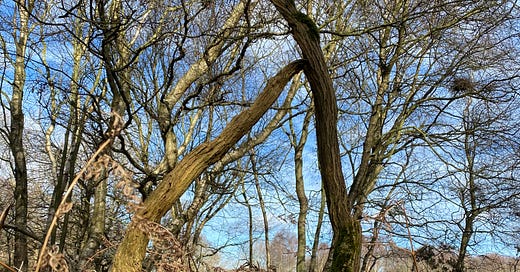


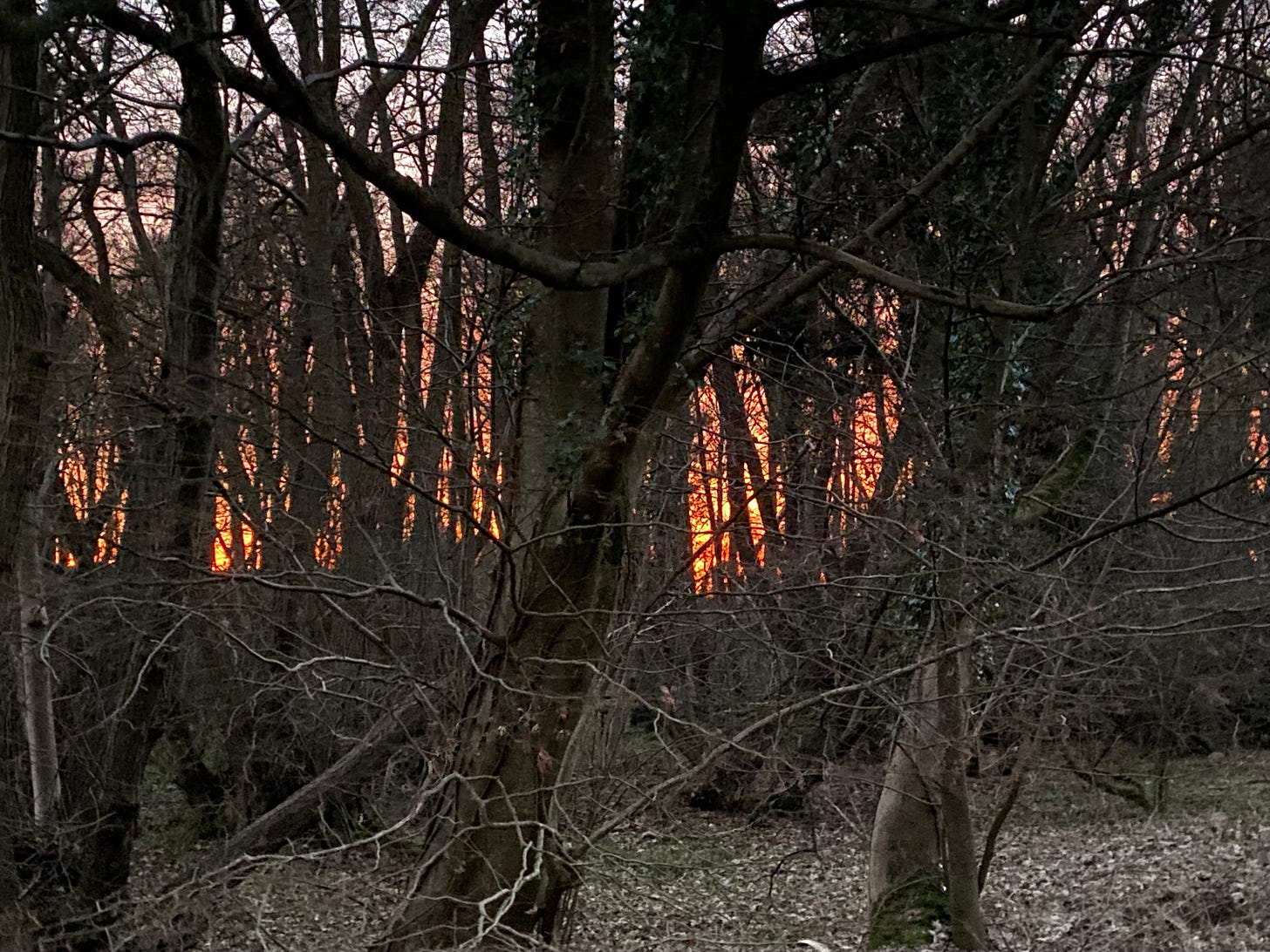
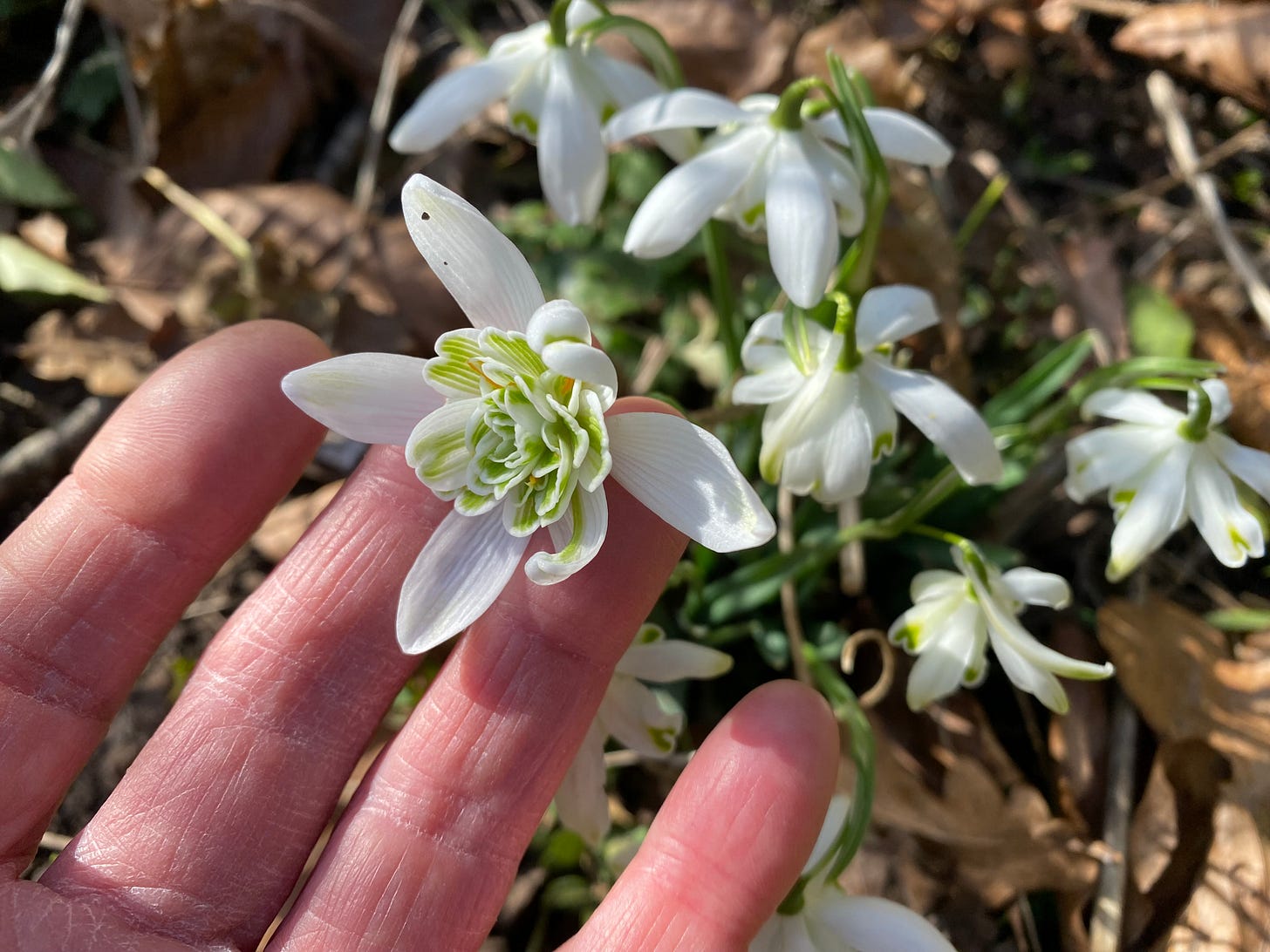
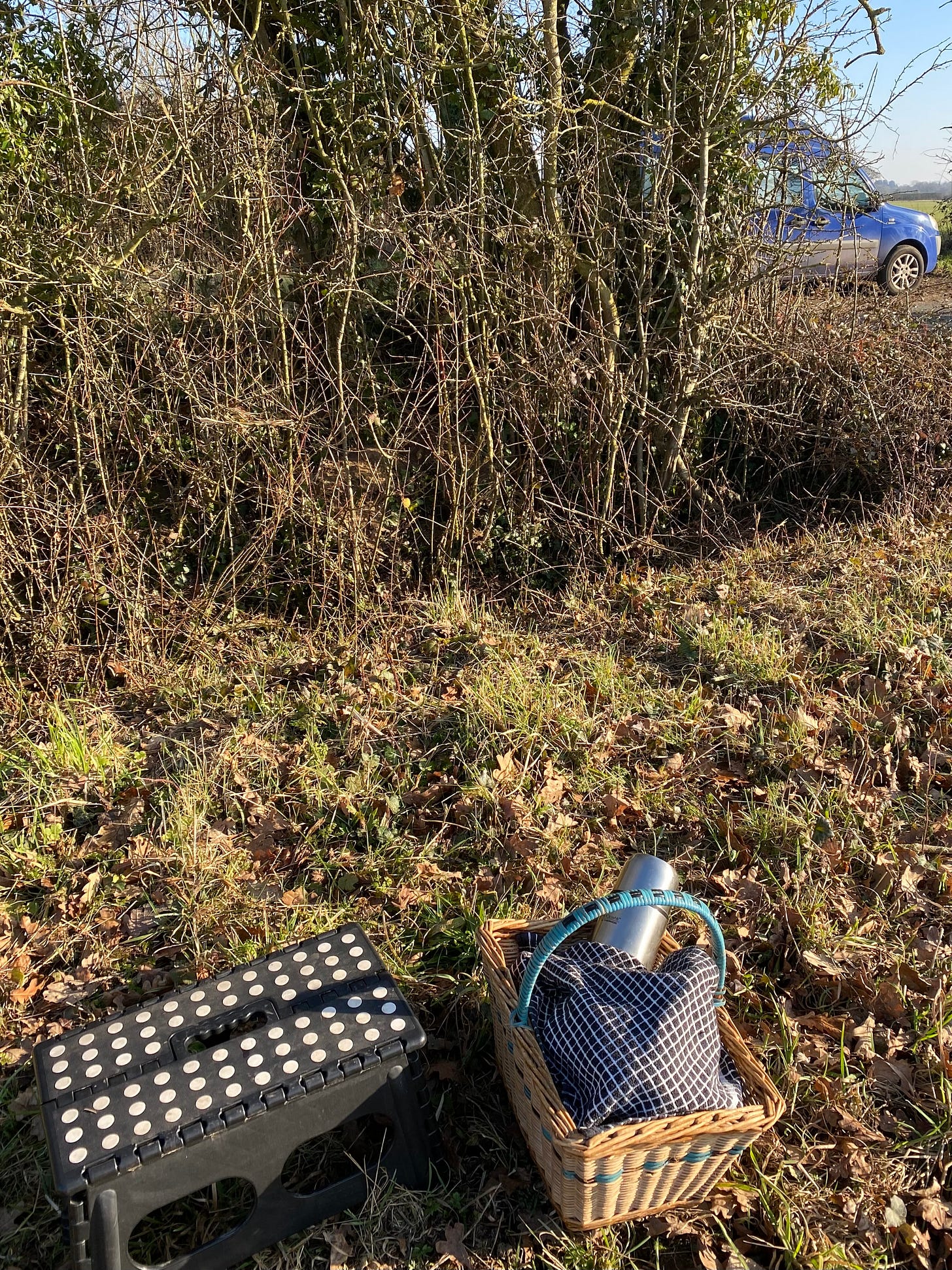


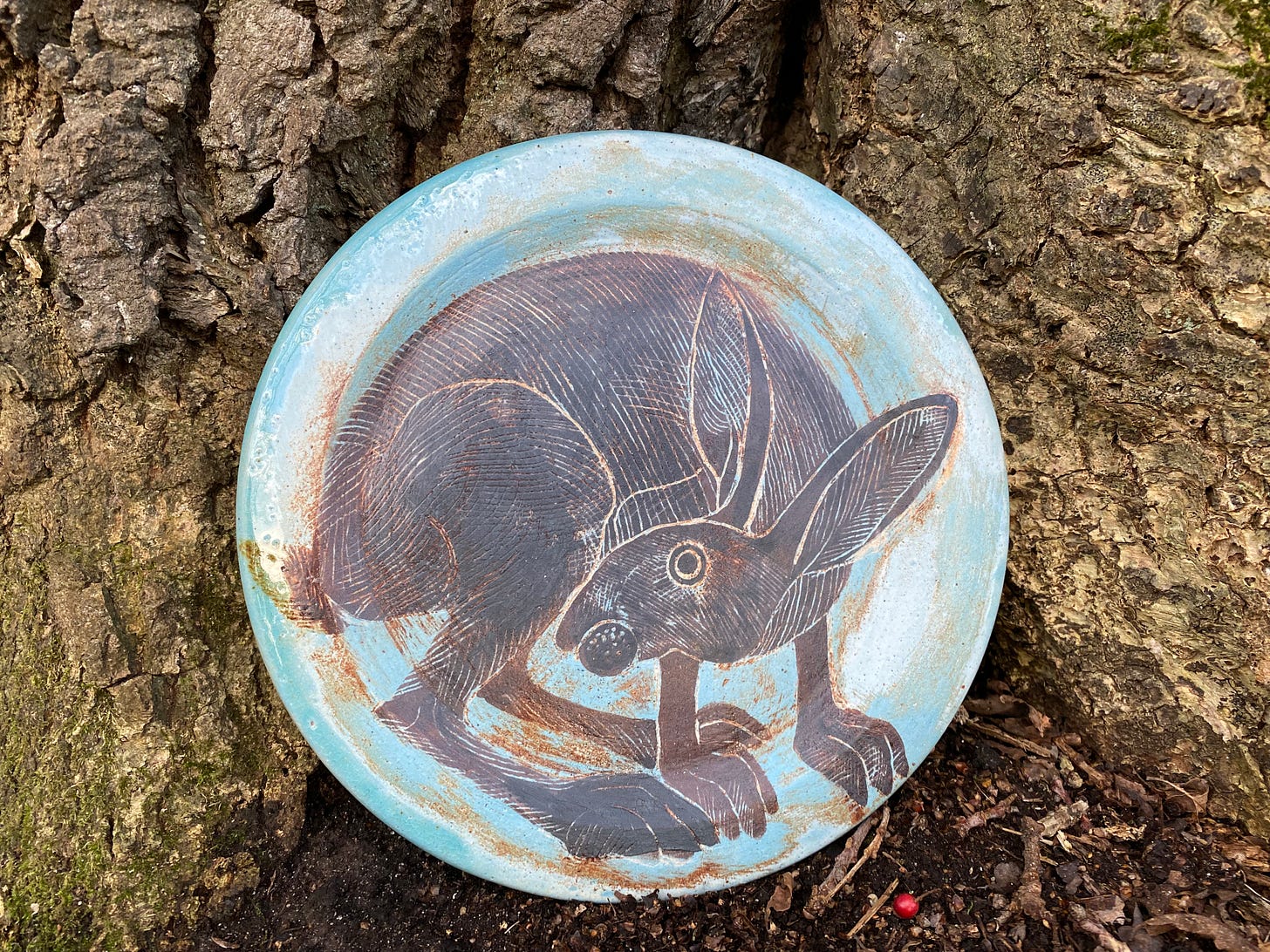
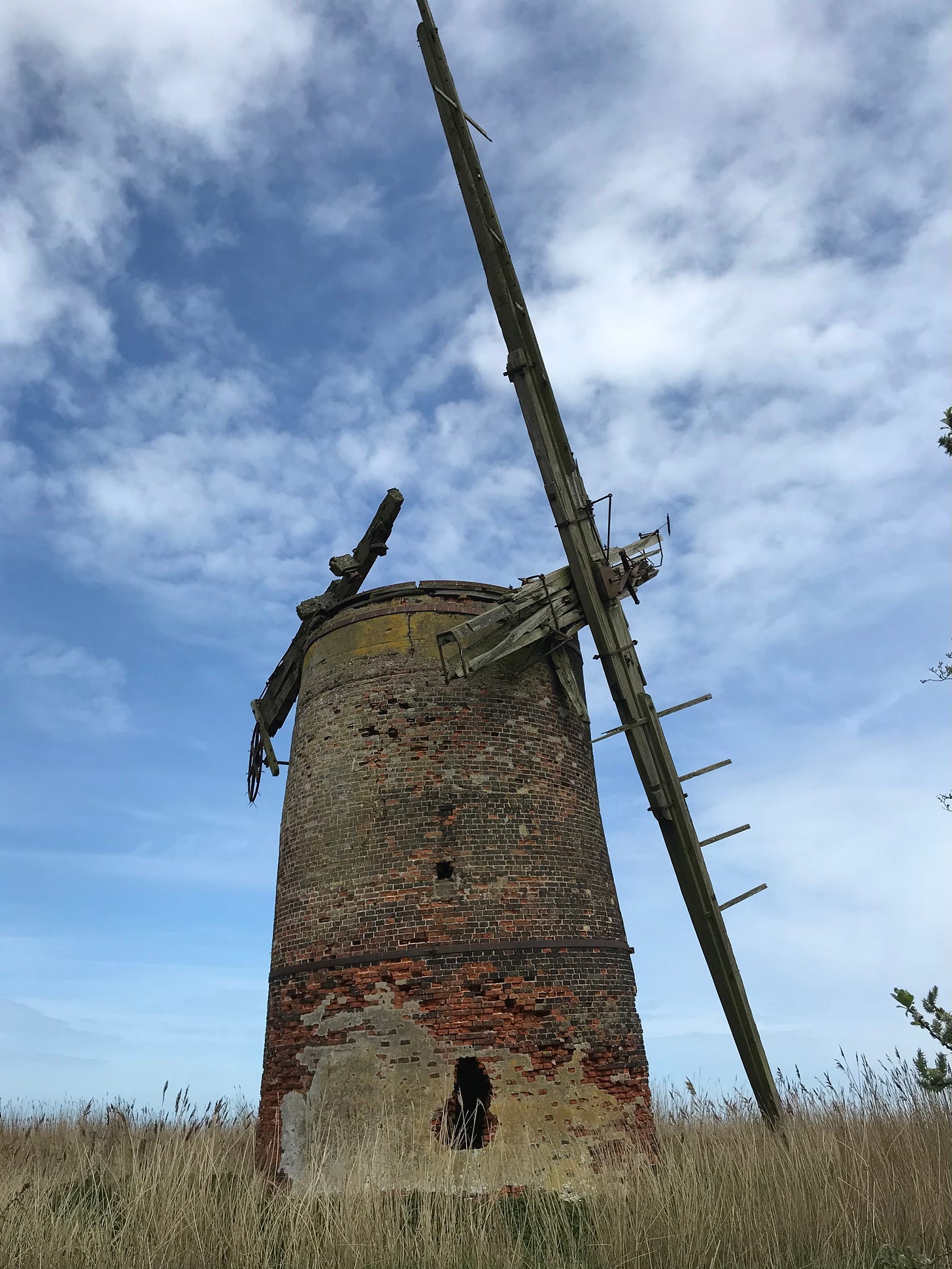
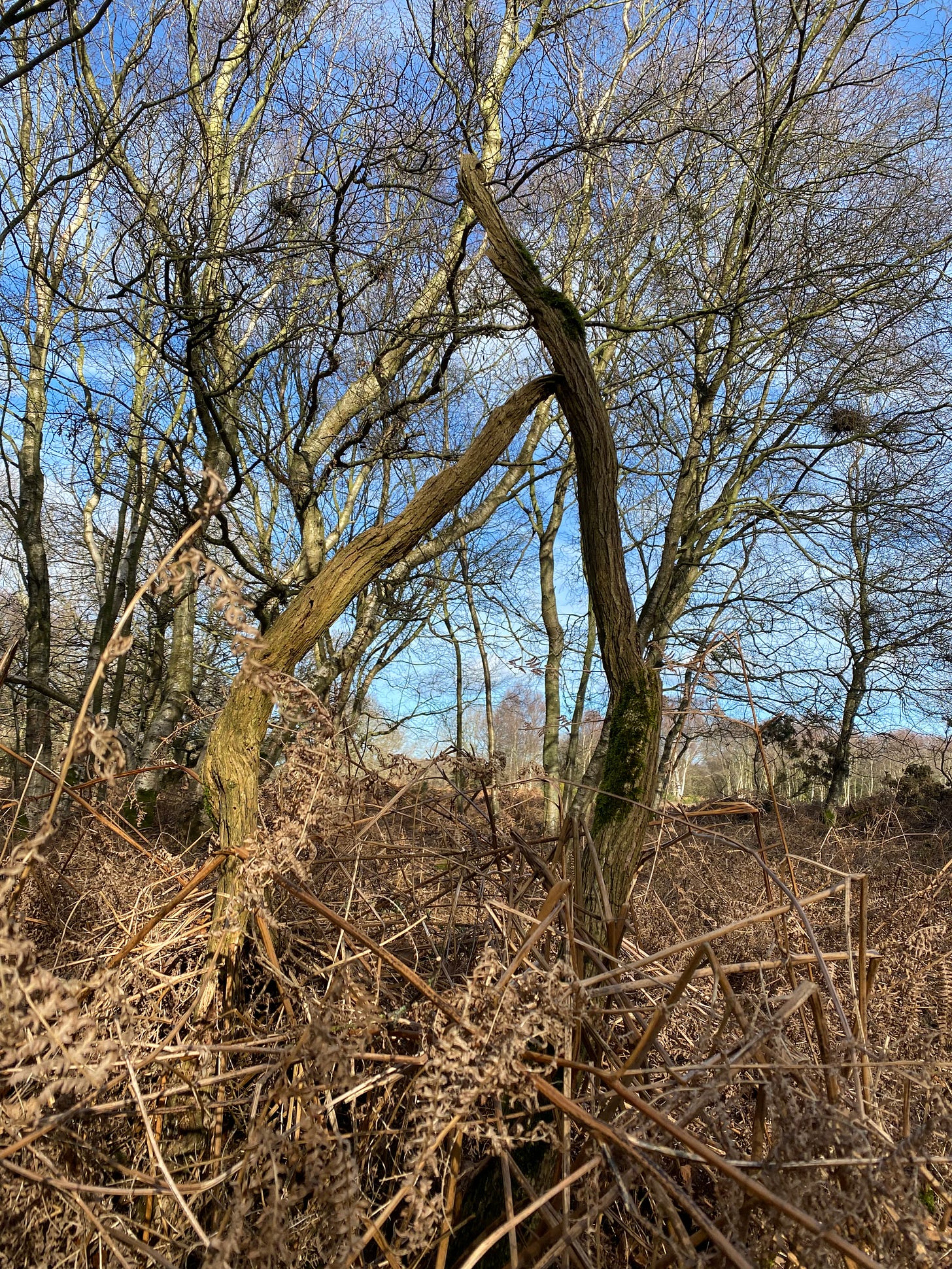
Thank you Imogen ! Such a beautiful gift to find in my email. The poems ,photos and fascinating writing and history about snowdrops . So lovely to hear about Walsingham I hope your visit there was full of lovely memories for you. I have been there many times years ago and treasure the place and the surrounding countryside. We often stayed in the old days at the old Sue Ryder " Martyrs house" opposite the Abbey entrance, we were often the only ones there overnight and had many paranormal experiences!
Love the Olney pancake day stories and your recipe made me Hungry
Take care from one left hander to another !
Love from Canada
Denise xo
Thank you for your stories of Shrove Tuesday. We know and celebrate it as Mardi Gras and have made the trip to New Orleans for the Carnival season many times. Besides the parades and costumes, the music and beads, one of my favourite things is the King Cake. An overly sweet white cake decorated garishly in Mardi Gras colours of purple, green and gold. A small “baby” is baked inside to represent the Christ child and whoever receives that slice is responsible for bringing the following year’s cake. Wherever the day’s parties start they always end in the French Quarter where, precisely at midnight, police walking, and on horseback sweep in from every entrance and clear the streets of revellers in anticipation of the following holy day of Ash Wednesday. I so love hearing your stories, your ancient customs and seeing where they differ and where they overlap.